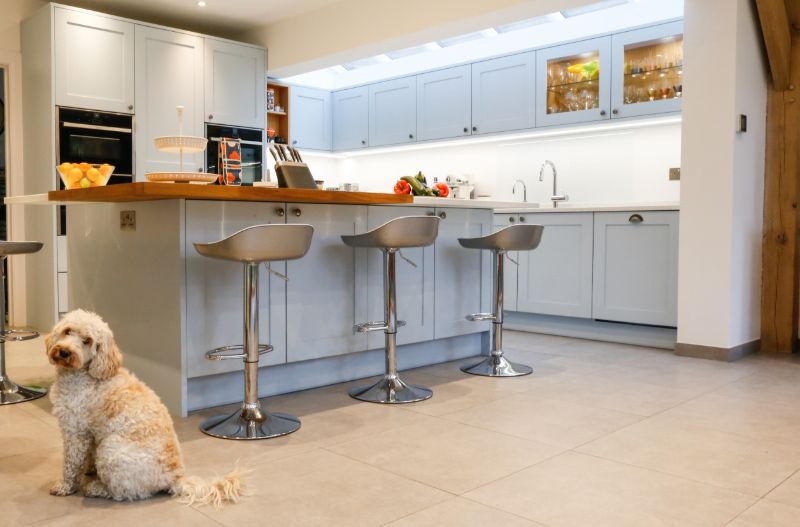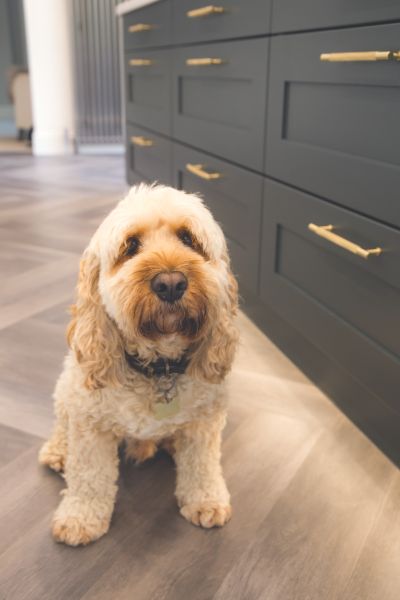A kitchen is for the whole family. As your pets are part of the family, it stands to reason you need to think of them too when choosing your new kitchen – by planning a pet friendly kitchen design. If nothing else, designing a kitchen with your pets in mind will mean they’re kept out of your way and you’ll be less likely to trip over them or their bowls, bed, etc. when you’re trying to make a meal. With a bespoke kitchen, you can create spaces especially for your pets. As these spaces will be all part of the plan, they won’t detract from the design of the room, and could even enhance it. Here are our tips on what you need to think about.
Food bowls
The most obvious impact pets are likely to have on your kitchen is where they eat. If you’ve introduced new pets to the family in your current kitchen, the likelihood is that their water and food bowls are cluttering up the floor space. With a bespoke kitchen design, you can create suitable spaces for your pets to eat that are out of your way, including a dedicated kitchen island with a pet feeding station. For cats and small dogs, this can involve the creation of a little alcove among your kitchen units.
Not only will this keep them out of the way when they’re eating, but it’ll also make them feel like they’re in a safe space. Do remember that it’s a good idea to keep the cat’s water bowl well away from their food bowl. In the wild, cats eat away from water to prevent their food from contaminating their drinking water, and domestic cats are thought to still follow this behaviour.
For larger dogs, you could incorporate space for food bowls into a ‘step’ under an extended worktop that overhangs one of the units, effectively integrating a kitchen island with a pet feeding station. This will keep the bowls out of your way, prevent the dogs from pushing their bowls around the kitchen, and give you a chance to raise the bowls, making it more comfortable for your dogs to eat while showcasing a clever kitchen innovation tailored to your pet’s needs.
Flooring
With pets around, you’ll obviously need a floor that’s easy to clean and less likely to get damaged by claws or bowls being thrown around. Therefore you need hard-wearing flooring such as porcelain or ceramic tiles or sealed laminate flooring. If you’re going to have underfloor heating, remember that your cats are more likely to sleep on it, so provide them with a cosy corner or alcove where they can take advantage of the warm floor without being tripped over!
Create safe hiding spaces
When animals get scared, they need to find somewhere they feel safe. There are many things that might frighten a cat or dog, such as sudden loud noises—fireworks on New Year’s Eve or Bonfire Night are the most obvious. Some animals are simply nervous and hide whenever visitors come around (indeed, we’ve all had visitors we’d have preferred to hide from, so who can blame them?).
By creating a space where your pets can hide and feel safe, you’ll rest easy knowing where they are. It’s all too easy for a frightened cat to bolt outside, become disoriented, and get lost.
Consider incorporating clever solutions like a cat or dog bed built into a cabinet for your furry friends. This gives them a cosy retreat when needed and keeps them safely indoors during stressful situations, ensuring their well-being and your peace of mind.
Integrated pet proof bins
Bins and pets can be a bad combination, especially where dogs are concerned! When designing your pet-friendly kitchen, you’ll need to keep this in mind and have the trash bin and recycling bins in a drawer or safely behind a cupboard door to prevent scavenging.
Consider investing in a cat- or dog-proof kitchen bin to deter your furry friend from getting into unwanted scraps. These specialised bins are designed to keep pets out, ensuring both a cleaner kitchen and your pet’s safety.
Integrated devices
In kitchens with freestanding ovens, fridges and other white goods, there are always nooks and crannies where pet toys and played-with food can end up (not to mention hiding space for any critters your cat may have brought inside). By integrating your white goods in your kitchen units, you’ll have a kitchen where there’s no chance of debris accumulating and which is easy to keep clean.
Handleless units
Handleless doors and drawers have many advantages when it comes to pets. They’re a lot easier to wipe down and keep clean, so you can keep them free of fur and muddy pawprints. They’re also a lot more likely to stay shut – clever animals soon work out how to pull cupboard handles to get to the goodies inside, but if there’s nothing for them to get hold of and pull at, their treats will only be available to them for good behaviour!




